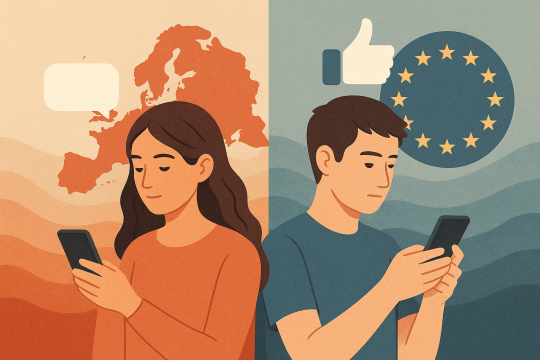In Western democracies, an unprecedented ideological divide appears to be emerging among younger generations. Young women are becoming more progressive, while young men are increasingly drawn to conservative and right-wing ideologies. Is this pattern also observed in Europe? And what’s driving this growing gender divide in political attitudes?

A study “Gender and political views in Europe: Is the divide widening among youth?” conducted within the PROSPER Research Center by Anna Bernard (Católica Lisbon) and Anna Jacobs (Bielefeld University, Kiel Institute for the World Economy), and funded by the La Caixa Foundation, reveals a key trend: in Europe, young women from Generation Z (born 1997–2012) and Millennials (1981–1996) are increasingly leaning to the left, while their male peers are shifting in the opposite direction.
"The most surprising finding is how sharp the shift to the left is among young women, compared with young men. Young men do shift toward the right, but the change is more moderate. The asymmetry itself is something worth investigating, and we are currently trying to find reasons why." - Anna Bernard
Using data from the European Social Survey (2008–2022) across 16 countries, the research shows that the ideological gap between young men and women is growing fast. Among Europeans aged 18 to 29, women are steadily leaning more leftward, while men’s views remain more stable or shift rightward. On a 0-to-10 political scale (0 = far left, 10 = far right), the gender gap grew from just 0.2 points in 2008/2009 to 0.7 points in 2021/2022, a more than threefold increase in just over a decade.

Northern and Western Europe Lead the Divide
This growing divide is especially prominent in Northern and Western Europe, where the gender gap is twice as large as in other regions. Countries like Finland, Sweden, Norway, France, and Belgium show some of the largest gender-based ideological differences.
In contrast, Southern Europe displays more variation. While Portugal mirrors Western Europe with a notable gender gap, Spain stands out for its overall left-leaning views across both genders.
In Eastern Europe, including Estonia, Lithuania, Czech Republic, and Hungary, the youth leans more to the right overall, regardless of gender, illustrating that the gender gap is not uniform across the continent.

The gap among the youth remains after adjusting for socio-demographic factors
Historically, women were more likely than men to support right-leaning political views. But since the mid-1990s, that pattern has reversed. This shift is partly explained by greater workforce participation, higher education levels, economic independence, and a decline in religious influence, all of which correlate with left-leaning political views.
Do these factors explain the modern gap? Even when accounting for education, income, marital status, or region, the gender gap remains six times larger among Generation Z and Millennials compared to older groups like the Generation X (born between 1965 and 1980), the Baby Boomers (1946–1964), or the Silent Generation (1928–1945).
The role of social media
As digital natives, young Europeans spend more time online than any other age group, averaging roughly two additional hours per day compared to older generations. Emerging research indicates that social media plays a role in shaping political preferences and may contribute to growing polarization. Could social media be driving the modern gender political gap?
"I suspect that social media has acted more as a catalyst, particularly in the shift observed among young women. Movements like #MeToo has increased awareness of systemic violence and prejudice towards women and likely contributed to a growing identification with progressive values among young women." - Anna Bernard
While exact measures of social media use are difficult to obtain, recent studies have used the rollout of 3G networks as a proxy for increased digital access. Introduced in the early 2000s, 3G enabled widespread mobile internet use and fueled a rise in social media engagement.
In their study, Anna Bernard and Anna Jacobs examine the relationship between mobile internet expansion and the gender political gap. A clear pattern emerges: in rural areas, greater 3G coverage is associated with a rightward shift among men, while urban women tend to move to the left. These patterns help explain the overall trend, as urban areas are characterized by denser population.

"The growing divide between young men and women raises important questions about social cohesion and, in the long term, even demographic dynamics. What we need to understand now is whether these differences remain political preferences or begin to harden into deeper forms of social opposition. One area we're exploring next is whether stepping back from social media has any measurable effect on the gender gap in political attitudes, particularly among younger users." - Anna Bernard
This research was funded by La Caixa (Project SR21-00783). It has already attracted media attention, with coverage in the French newspaper Libération, the French radio France Inter, and LUX magazine. You can read the full study here.